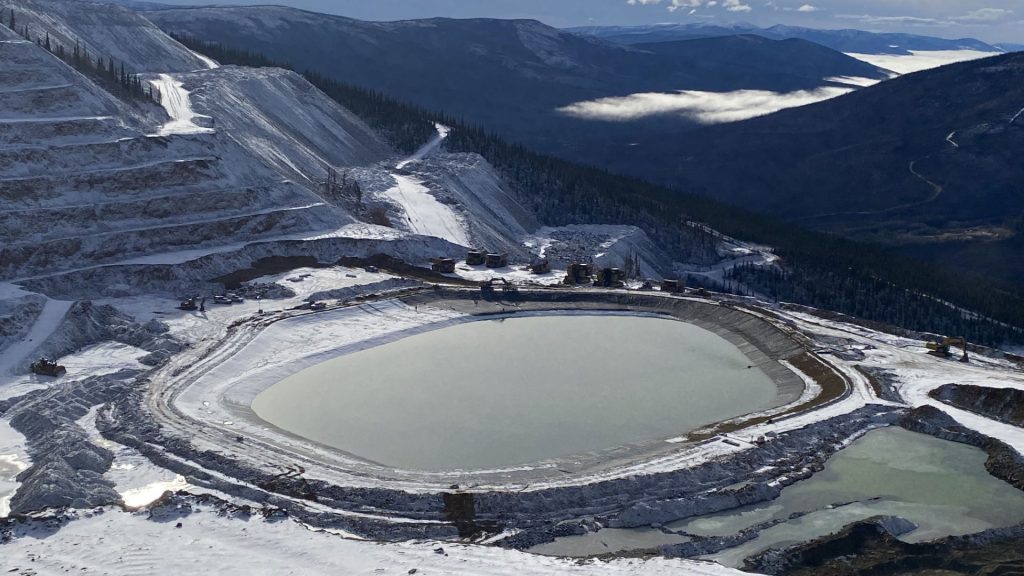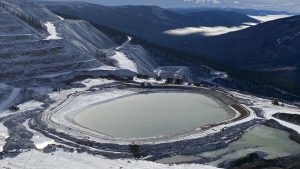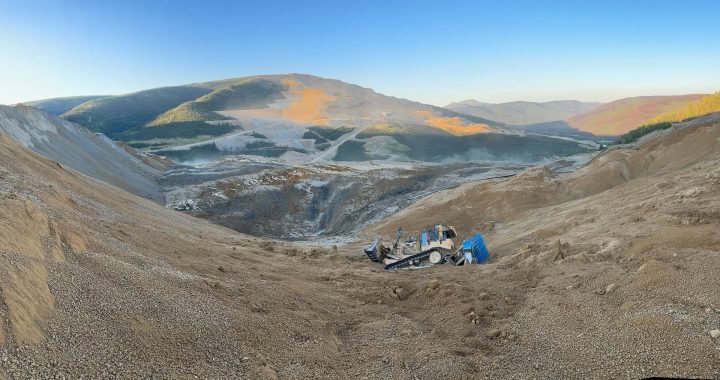
A recently expanded water storage pond at the Eagle Gold mine site. Photo: Victoria Gold Corp
The company managing the takeover of the Eagle Gold Mine on First Nation Na-Cho Nyäk Dun’s (FNNND) traditional territory in Yukon is asking for its water licence to be relaxed on an emergency basis or risk an uncontrolled discharge of cyanide.
PricewaterhouseCoopers (PwC) took over as receiver for the Eagle Gold Mine near Mayo, Yukon, from Victoria Gold in August.
In an application filed to the Yukon Water Board earlier this month, PwC is asking for the Effluent Quality Standards (EQS) of the mine’s water licence to be temporarily loosened in order to allow partially treated cyanide-contaminated water to be released into nearby Haggart Creek.
The application states the discharged water would not meet current EQS standards, though it also would not be “acutely toxic at the point of discharge.”
“The objective is to allow prioritizing stable containment of the untreated cyanide impacted water and not to permanently amend the established long-term water quality objectives set out in current License conditions,” the application states.
On June 24, the mine experienced a landslide causing roughly four million tonnes of ore to spill, two million of which escaped containment. The facility used a technique called “heap leaching” where ore is saturated in cyanide to separate the gold from the rock. The failure released cyanide saturated ore that was stored in the heap leach facility into the surrounding environment.
In August, an Ontario court appointed PwC to take over the site and direct the clean up.
Its application states large amounts of cyanide contaminated water and non-contaminated contact water stored at the site is mixing together, increasing the risk of discharge.
PwC said its team is currently unable to separate the contaminated and non-contaminated water. According to PwC, while a water treatment plant on site is currently being reconfigured to treat cyanide impacted water, its current facilities are unable to do so due to the standards stipulated in its water licence.
It noted as of Nov. 4, approximately 508,000 cubic meters of cyanide-contaminated water is being stored in water storage ponds. The total water storage capacity on site is roughly 633,000 cubic meters, which includes about 314,000 cubic metres of storage capacity constructed since the failure.
It said in addition to the water stored in ponds, there’s an estimated 250,000 cubic meters of water being constantly recirculated into the heap leach facility, not including water already stored within the now full in-heap pond.
“The constant recirculation of water onto the (heap leach facility) has potential implications for the overall stability of the (facility) and cessation of this practice as soon as practicable has been recommended by various technical experts. Also, a substantial amount of cyanide impacted water has been released into groundwater, and this solution will have to be collected, stored and treated,” it said.
The application states while several new ponds have been built, construction of additional ponds is limited due to the site’s topography and the location of existing facilities.
“It is not realistic to rely on the construction of additional water storage ponds to contain additional water, while waiting for the water treatment processes to be able to fully satisfy the EQS of the Licence,” it said.
The application said if an amendment is not made to the licence in the near future storage capacity at the site will be exceeded by early January 2025.
“Furthermore, there is a considerable risk that adequate storage capacity for freshet water flows will not be available by April 2025, which further heightens the risk of releasing cyanide contaminated water into the environment,” it said.
The application asks that the mine’s water licence be relaxed until March 31, 2025.

First Nation weighs in
FNNND Chief Dawna Hope said in a submission to the board she understood the urgent need for the discharge of non-compliant effluent.
She acknowledged the discharge would be necessary due to Victoria Gold’s “mismanagement” of the site.
“Put simply, the present emergency has been caused by (Victoria Gold’s) failure to maintain the integrity of the (heap leach facility) and (Yukon government’s) failure to adequately enforce licence provisions,” she said.
“FNNND considers the discharge of any water that does not meet effluent standards to be unacceptable and presumptively unlawful,” she further noted.
Hope’s submission recalled how a previous release of cyanide contaminated water by Victoria Gold during late summer while it was still responsible for the site caused the deaths of 68 fish in Haggart creek.
“As the board must be aware, considerable damage, including fish deaths, has already been inflicted on Haggart Creek, which remains subject to ongoing impacts and continued risk from the ongoing migration of contaminated groundwater into the creek,” she said.
Hope’s submission recommends PwC meet water quality objects by March 15 before arctic grayling begin staging at the confluence of Haggart creek and the South McQuesten River.
She also suggests increased monitoring, sharing collected data and exploring the feasibility of discharging effluent into the upper portion of Eagle creek as it flows through a small wetland area and a small pond before entering Haggart creek.
“This route may offer an opportunity for attenuation of some contaminants before the flows reach Haggart creek,” she said.
Read More:
20 seconds of terror: Surviving the Eagle Gold Mine landslide
Yukon government likewise wrote a submission to the board stating its support of the proposed discharge.
“(Yukon government) recognizes that the existing water licence is no longer representative of current site conditions and there could be impacts that were not previously considered in licensing processes such as impacts to human health,” it said.
The board has tentatively scheduled a special sitting to consider PwC’s request on Nov. 26.
According to a recent update from the government, levels of cobalt and cyanide continue to increase in Haggart Creek, though mercury levels have stabilized.
It also noted cobalt, mercury and cyanide has been detected in exceedance of water quality objectives three kilometers downstream of the mine.
FNNND continues to call for a public inquiry into the heap leach failure.









